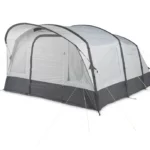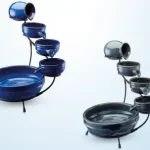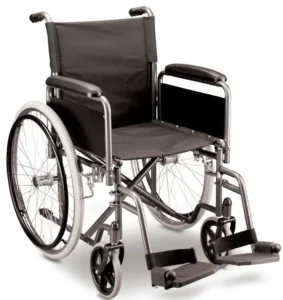
Foldable Wheelchair
USER MANUAL
Welcome
Congratulations on choosing to buy a Wellness Plus® product. All products brought to you by Wellness Plus® are manufactured to the highest standards of performance and safety and, as part of our philosophy of customer service and satisfaction, are backed by our comprehensive 1 Year Warranty. We hope you will enjoy using your purchase for many years to come.
Symbol Legend
IMPORTANT: DO NOT USE YOUR WHEELCHAIR UNTIL THIS MANUAL HAS BEEN READ AND UNDERSTOOD.
DANGER! Warning messages regarding possible risks of serious accidents or death.
WARNING! Warning messages regarding possible risks of injury. CAUTION! Warning messages regarding possible technical damage.
NOTE: Information for operating the product.
Use
Light-weight wheelchairs are exclusively for a user who is unable to walk or has limited mobility, for their own personal use in and outdoor on dry, firm and level surface terrain. The maximum weight limit (includes both the user and any weight of accessories fitted to the wheelchair) is marked on a label. Warranty can only be honored if the product
is used under the specified conditions and for the intended purposes. DO NOT use or fit any 3rd party components to the wheelchair.
Area of application
The variety of fitting variants as well as the modular design means that it can be used by those who cannot walk or have limited mobility because of the:
- Paralysis
- Joint contractures/joint injuries
- Illnesses such as heart and circulation deficiencies, disturbance of equilibrium, or cachexia
- Elderly people who still have strength in the upper body.
When considering provision, please also note the body size, weight, physical and psychological constitution, age of the person, living conditions, and environment.
Intended Use
This product is designed for personal use only and is not intended for commercial, healthcare, or trade use.
General safety notes and driving restrictions
The engineering and construction of this wheelchair have been designed to provide maximum safety. International safety standards currently in force have either been fulfilled or exceeded in parts. Nevertheless, users may put themselves at risk by improperly using their wheelchairs. For your own safety, the following rules must be strictly observed.
Unprofessional or erroneous changes or adjustments increase the risk of accidents. As a wheelchair user, you are also part of the daily traffic on streets and pavements, just like anyone else. We would like to remind you that you are therefore also subject to any and all traffic laws. Be careful during your first ride in this wheelchair. Get to know your wheelchair.
Before each use, the following should be checked:
- Fixed axles or on the rear wheels.
- Hook and loop tapes on seats and backrests
- Tyres and wheel locks. Before changing any of the adjustments of this wheelchair, it is important to read the corresponding section of the user’s manual. It is possible that potholes or uneven ground could cause this wheelchair to tip over, especially when riding uphill or downhill. When riding forwards over a step or up an incline, the body should be leaning forward.
- NEVER exceed the maximum load of 120 kg for user plus any items carried on the wheelchair. If you exceed the maximum load, this can lead to damage to the chair, or you may fall or tip over, lose control, and may lead to serious injury to the user and other people.
- Do not exceed the maximum load of 2kg inside the storage pocket
- When it is dark, please wear light clothing or clothing with reflectors, so that you can be seen more easily. Make sure that the reflectors on the side and back of the wheelchair are clearly visible.
- We would also recommend that you fit an active light.
DANGER!
- To avoid falls and dangerous situations, you should first practice using your new wheelchair on level ground with good visibility.
- When getting on or off the wheelchair, do not use the footboards.
- These should be flipped up beforehand and swung to the outside as far as possible. Always position yourself as close as possible to the place where you wish to transfer to.
- Only use your wheelchair with care. For example, avoid traveling against an obstacle without braking (step, curb edge) or dropping down gaps.
- The wheel locks are not intended to stop your wheelchair in motion. They are only there to ensure that your wheelchair does not begin rolling unintentionally. When you stop on uneven ground, you should always use the wheel locks to prevent unintended movement. Always apply both wheel locks; otherwise, your wheelchair could tip over.
- Explore the effects of changing the center of gravity on the behavior of the wheelchair in use, for example on inclines, slopes, all gradients, or when overcoming obstacles. Do this with the secure aid of a helper.
- With extreme settings and less-than-perfect posture, the wheelchair may tip over even on a level surface.
- Lean your upper body further forward when going up slopes and steps.
- Lean your upper body further back when going down slopes and steps. Never try to climb and descend a slope diagonally.
- Avoid using an escalator which may lead to serious injury in the event of a fall.
- Do not use the wheelchair on slopes more than 10°. The Dynamic safe slope is dependent on the chair configuration, the user’s abilities, and the style of riding. As the user’s abilities and style of riding cannot be predetermined then the max safe slope cannot be determined. Therefore this must be determined by the user with the assistance of an attendant to prevent tipping.
- It is possible that potholes or uneven ground could cause this wheelchair to tip over, especially when riding uphill or downhill.
- Do not use your wheelchair on muddy or icy ground.
- Do not use your wheelchair where pedestrians are not allowed.
- To avoid hand injuries do not grab in between the spokes or between the rear wheel and wheel lock when driving the wheelchair.
- Fingers will easily become hot when braking at a high speed or on long inclines.
- Only attempt stairs with the help of an attendant. There is equipment available to help you, e.g. climbing ramps or lifts, please use them. If there is no such equipment available, then the wheelchair must be tipped and pushed, never carried, over the steps (2 helpers). We recommend that users over 80 kg in weight are not transferred in this way.
- Make sure that the attendant only holds the wheelchair using securely mounted parts. Do not use removable parts (e.g. not on the footrests or the armrests).
- Secure your wheelchair on uneven ground or when transferring.
- This wheelchair is not a crash-tested chair, and users should never stay in the chair while in a vehicle.
- Depending on the diameter and setting of the castors, as well as the center of gravity setting of the wheelchair, the castors may begin to wobble at high speeds. This can lead to castor seizure and the wheelchair may tip over.
- In particular, do not travel on an incline without brakes, travel at a reduced speed.
- When reaching for objects (which are in front of, to the side, or behind the wheelchair) make sure that you do not lean too far out of the wheelchair, as if you change the center of gravity there is a risk of tipping or rolling over. The hanging of additional load (backpack or similar items) onto your chair’s back posts can affect the rearward stability of your chair, especially when used in combination with recliner backrests. This can cause the chair to tip backward causing injury.
- If the seat and back sling is damaged, you must replace them immediately.
- Be careful with fire, in particular with burning cigarettes. Seat and back slings can be set alight.
- If the wheelchair is subject to direct sunlight / cold temperature for a long period of time, then parts of the wheelchair (e.g. frame, legrests, brakes, and side guard) may become hot (>41°C) / very cold.
Handling
FOLDING UP
First remove any seat cushion or the back seat shell from the wheelchair and flip up the (platform) footplate or the individual footrests.

Take hold of the seat sling fabric in the middle, at the front, and the back, and pull upwards. The wheelchair will then fold up.

To fold your wheelchair so that it is as small as possible, e.g., to put it into a car, you can remove the footrests. For this purpose, open the latch from the inside and swing the footrest to the side. Then the footrest only has to be drawn out of the receiver tube.
UNFOLDING
Tip the wheelchair on an angle while standing at the side of the wheelchair.
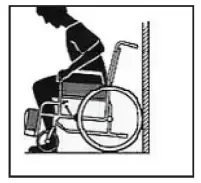
Press down on the seat tube nearest to your body. Your wheelchair is then unfolded. Now ensure the seat tubing is right down and into position. Be careful not to get your fingers caught in the cross-tube assembly.
GETTING INTO YOUR WHEELCHAIR INDEPENDENTLY
- The wheelchair should be pushed up against a wall or solid piece of furniture;
- The brakes should be on;
- The footplates should be hinged up;
- The user can then lower himself into the chair;
- The footplates should then be pushed down and the feet rested on them in front of the heel loops.

GETTING OUT OF YOUR WHEELCHAIR INDEPENDENTLY
- The brakes should be on;
- The hinged footplates should be hinged up;
- With one hand on each armrest, the person should bend slightly forward to bring the body weight to the front of the seat, and with both feet firmly on the ground, one foot well back, push up into the upright position.
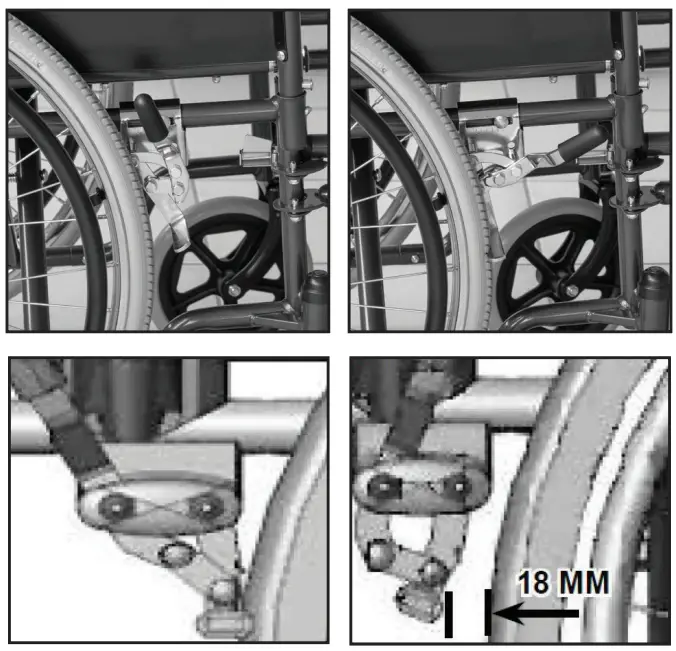
WARNING!
- When standing, do not stand on the footplates or the wheelchair will tip up. It is easier and safer to get into your wheelchair if you turn the footplates up and out of the way or take them off the wheelchair.
- Always engage the wheel brakes when transferring in or out of the wheelchair.
STEP TUBES
Step tubes are used by attendants to tip a wheelchair over an obstacle Simply step on the tube to push a wheelchair, for example, over a kerb or step.

WHEEL LOCKS
Your wheelchair is equipped with two-wheel locks. They are applied directly against the tyres.

To engage, press both brake levers forward against the stops. To release the locks, pull the levers back to their original positions. Braking power will decrease with:
- Worn tyre tread
- Wet tyres
- Improperly adjusted wheel locks. The wheel locks have not been designed to be used as brakes for a moving wheelchair. The wheel locks should therefore never be used to brake a moving wheelchair. Always use the hand rims for braking. Make sure that the gap between the tires and wheel locks complies with the given specifications. To readjust, loosen the screw and set the appropriate gap. Then re-tighten the screw.
CAUTION!
- After each adjustment of the rear wheels, check the wheel lock gap and re-adjust if necessary.
- Mounting the wheel lock too close towards the wheel will result in a higher effort to operate. This might cause the brake lever extension to break!
- Leaning onto the brake lever extension while transferring will cause the lever to break! Splashing water from tyres might cause the wheel lock to malfunction.
FOOTPLATES:
The footplates can be flipped up to make it easier to transfer to/from the chair.
Lower leg length:

For users with longer legs, the leg support can be lowered to the appropriate level by using the bolt located on the base of the footrest. Loosen the bolt, push the tubes to the desired position and then re-tighten the screws. If jammed lightly tap the bolt on a solid surface.
There must always be a minimum gap of 2.5 cm between the footplates and the ground.
ARMRESTS
The armrest will support the user.
- To remove the armrest, push the pin (1), so that the armrest is released.
- Use both hands to lift the armrest out of its location spots.
- To put the armrest in, line up the location spots and push down with a small amount of pressure.

TECHNICAL SPECIFICATION
| Overall Width | 66cm |
| Overall Height | 91cm |
| Overall Length | 109cm |
| Folded Width | 29cm |
| Total Weight | 19.1kg |
| Weight Capacity | 120kg |
| Max Weight for Storage Pocket | 2kg |
| Seat Dimensions | 46 x 40cm |
| Seat-to-Floor Height | 49cm |
| Seat Back Height | 41cm |
| Colour | Titanium |
MAINTENANCE:
- Check all tyres for wear and damage at regular intervals, at least annually. Change the tires as soon as there is any sign of damage or wear.
- Check the seat and back sling for wear and damage at regular intervals, at least annually. Change these items as soon as there is any sign of damage or wear.
- Check all frame and backrest components for wear and damage at regular intervals, at least annually. Change these items as soon as there is any sign of damage or wear.
- Check the brakes for wear and damage at regular intervals, at least annually. Check that they are working properly and are easy to use. Change the brakes as soon as there is any sign of damage or wear.
- Check to make sure all bolts are secure at regular intervals, at least annually. All screws which are critical to using the wheelchair safely have safety nuts. Safety nuts should only be used once and should be replaced after use.
- Please use only mild household cleaners when your wheelchair is dirty. Use only soap and water when cleaning the seat upholstery.
- Depending on the frequency and type of use, we recommend taking your wheelchair to your authorized dealer regularly, but at least within a year, to have it maintained by trained personnel.
CAUTION!
Sand, salt, and seawater can damage the bearings of the front and rear wheels. Clean and dry the wheelchairs carefully, after they have been exposed to these elements.
HYGIENE WHEN BEING REUSED:
When the chair is to be reused, it should be prepared carefully, and be wiped and treated with spray disinfectant on all surfaces which could come into contact with the user. If you need to do this quickly, you must use a liquid, alcohol-based disinfectant suitable for medical products and devices.
TROUBLESHOOTING
Wheelchair pulls to one side
- Check tyre pressure
- Check to make sure wheel turns easily (bearings, axle)
- Check the castor angle
- Check to make sure both castors are making proper contact with the ground or castors may begin to wobble
- Check to make sure all bolts are secure; tighten if necessary (see the section on torque)
- Apply small amount of lubrication to spots where movable parts come in contact with one another
- Check to see if rear wheels are adjusted differently
- All parts are available through Care Quip, who hold spare parts specifically for this model
MANUFACTURER AND AUSTRALIAN SPONSOR
Care Quip
PO BOX 6308
Silverwater NSW 1811
02 9714 1111
[email protected]

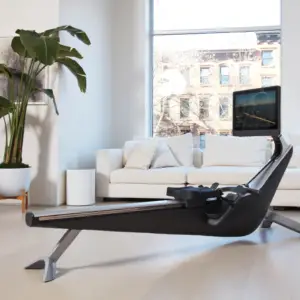
Warranty Details
REGISTER YOUR PURCHASE AT www.aldi.com.au/en/about-aldi/product-registration/ TO KEEP UP-TO-DATE WITH IMPORTANT PRODUCT INFORMATION
The product is guaranteed to be free from defects in workmanship and parts for a period of 12 months (dependent on the product) from the date of purchase. Defects that occur within this warranty period, under normal use and care, will be repaired, replaced, or refunded at our discretion. The benefits conferred by this warranty are in addition to all rights and remedies in respect of the product that the consumer has under the Competition and Consumer Act 2010 and similar state and territory laws.
Our goods come with guarantees that cannot be excluded under the Australian Consumer Law. You are entitled to a replacement or refund for a major failure and for compensation for any other reasonably foreseeable loss or damage. You are also entitled to have the goods repaired or replaced if the goods fail to be of acceptable quality and the failure does not amount to a major failure.
AFTER SALES SUPPORT
0297141111
AUS Hotline Costs
1 YEAR WARRANTY
[email protected]
MODEL: NC0270 PRODUCT CODE: 18662 03/2022
